Greek Letters as Numerals. Dated coins usually have officina letters (numbers) A, B, Γ, Δ, Є, Greek for 1 through 5. Most of the other Greek letters Page 1 noted that "M" for 40, "K" for 20, and "I" for ten are common. "Λ" for 30 is uncommon.
Γ is gamma, our G, and it is 3 as a numeral.
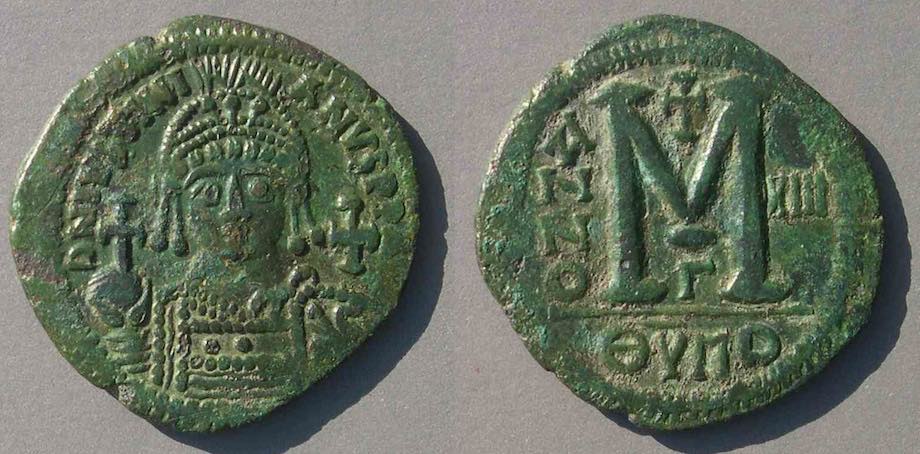 Officina Γ (= 3) below the middle of the M
Officina Γ (= 3) below the middle of the M
on a year XIII = 13 coin of Justinian (527-565)
minted at Antioch after it was renamed Theoupolis
ΘYΠO abbreviating "Theoupolis" in Greek.
ThUPOlis
Very large. 39 mm. 20.77 grams. (This image is smaller than proportional.)
The obverse legend is
DN [Dominus Noster, our lord]
IVSTINI-ANVS
PP [PerPetuus] AVG
Sear 218.
The fascinating story of Antioch being renamed Theopolis and its many different mintmarks is told here.
Δ is delta, our D, and it is 4 as a numeral.
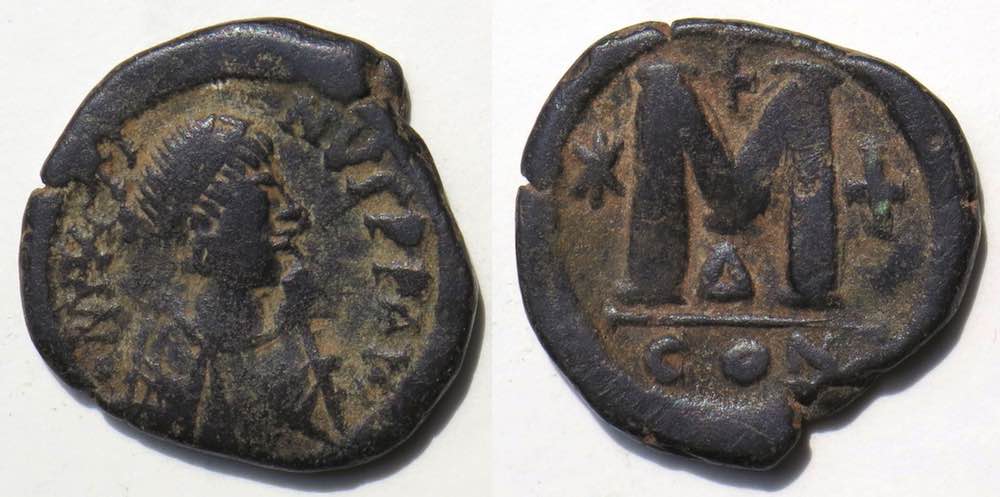
Justin I, 518-527.
Follis. 32-30 mm. 16.42 grams.
Officina Δ (= 4) [below the middle of the M]
CON for Constantinople.
Sear 63.
Rare denominations and their mints
Thessaloncia. The mint of Thessalonica (on the Greek coastline northeast of Athens) issued some unusual denominations under Justinian including a 16-nummus piece.
 Justinian, 527-565.
Justinian, 527-565.
18 mm. 5.44 grams.
"S" is a Greek symbol for "6". With "I" for "10", this coin is a 16-nummus piece.
A P on either side with various symbols above the I. This one has •
H •
.
TЄS for Thessalonica.
Sear 180.
There is a rare "H" piece for 8 nummi.
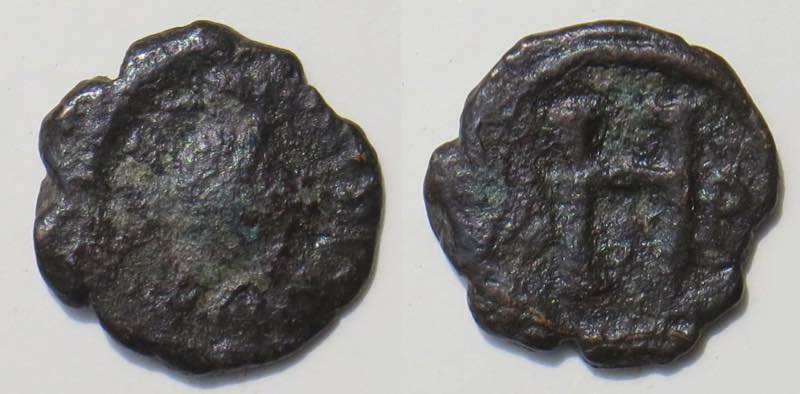 Justinian, 527-565.
Justinian, 527-565.
17-16 mm. 2.50 grams.
8-nummus piece.
H, with A P on either side.
This example is in poor condtion.
Sear 192A. Thessalonica.
The 4-nummus piece has a large Δ for 4 nummi.
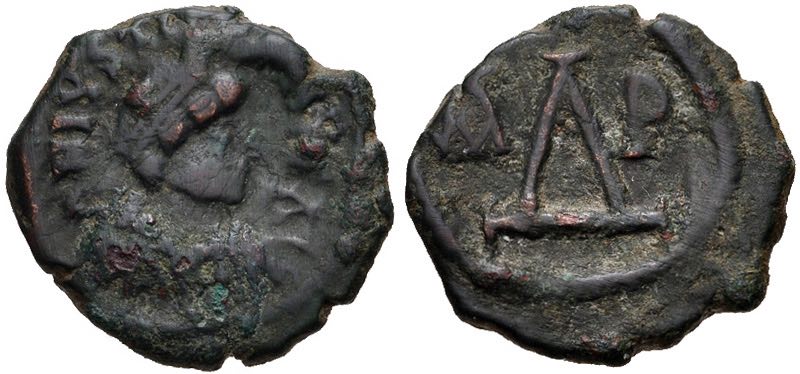 Justinian (527-565)
Justinian (527-565)
4-nummus piece. 14 mm. 1.63 grams.
Δ A P either side
Sear 194. Thessalonica.
Thessalonica also issued regular denominations.
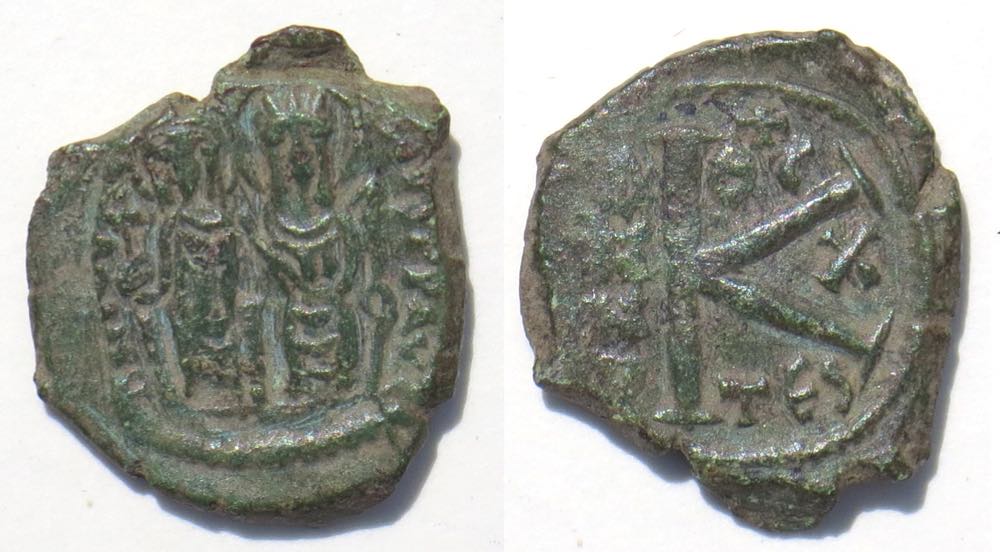
Justin II and Sophia, 565-578
22-19 mm. 5.73 grams.
20-nummus. Year X = 10
at TES = Thessalonica
ΘC above, a second mintmark of Thessalonica, this time in Greek.
Sear 366. Mint of Thessalonica.
It was a regular mint until 630 under Heraclius and became a mint again centuries later under Alexius I (1081-1118). Although each early emperor minted at Thessalonica, its coins are scarce and, unlike other mints, the 20-nummus denomination is much more common than the follis denomination which is rare.
Another Rare Denomination. Λ (lambda, our L) is Greek for 30.
 Λ
Λ
with ANNO down the left and XX down the right.
Heraclius, 610-641. 26-22 mm. 5.71 grams.
Heraclius and Heraclius Constantine standing.
Officina Δ.
CON (obscure) in exergue.
Sear 812. This type is never well-struck and the reason for issuing this denomination is a mystery. It is only known from years XX and XXI.
Alexandria, Egypt. The mint of Alexandria was open (c. 525-646) from Justin I until early in the reign of Constans II (641-668) when it was lost to the Arabs. It did not use the follis and its fractions, rather its own denominations: 33-nummus (rare), 12-nummus (common), 6-nummus (scarce), and very rare 3-nummus and 1-nummus pieces.
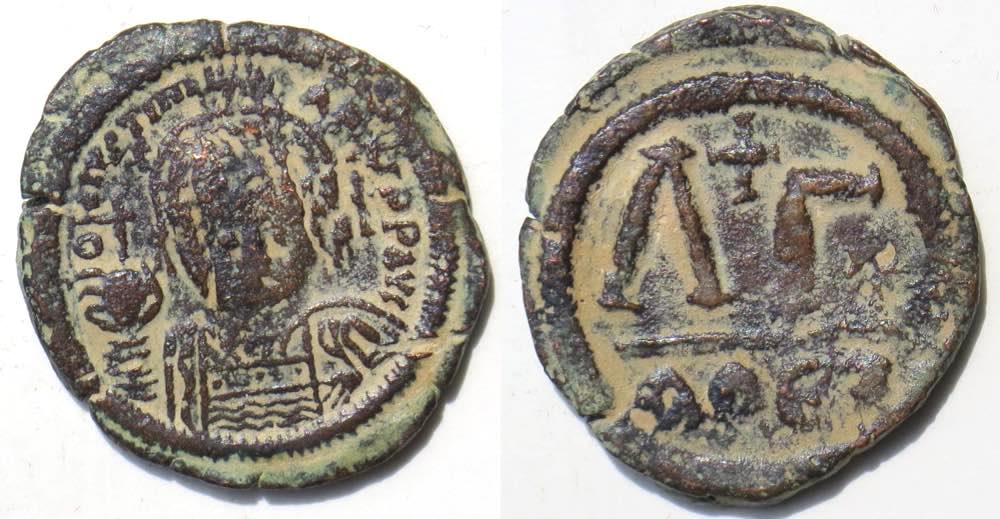 Justinian, 527-564
Justinian, 527-564
32-30 mm. 12.41 grams
Λ Γ (= 33), with a cross between,
AΛЄΞ in exergue, for Alexandria.
Sear 246. Rare.
Next is the "12" denomination repeated from page 1. A substantial majority of coins from Alexandria are of this denomination. The next coin is repeated from page 1.
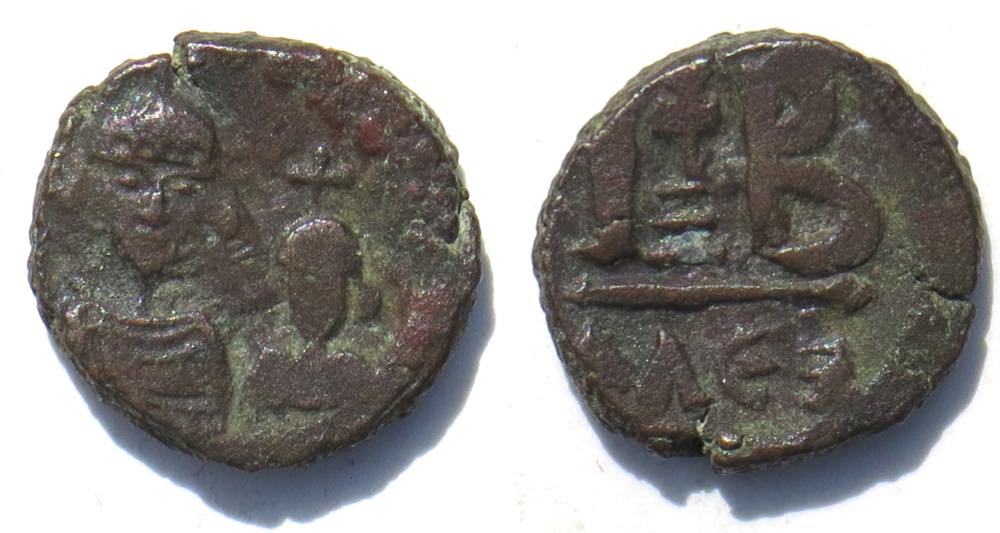 Heraclius, 610-641.
Heraclius, 610-641.
17 mm. 5.61 grams. This type is slightly thicker than other Byzantine coins.
Heraclius and his son Heraclius Constantine.
I B There is a cross between them.
I is 10 and B is 2 in Greek, for a total of 12.
The exergue has AΛЄΞ for Alexandria.
Sear 853. Common.
There are, of course, scholarly theories about why Alexandria used such odd denominations, but a clear and convincing reason has not emerged.
Next is a 6-nummus piece:
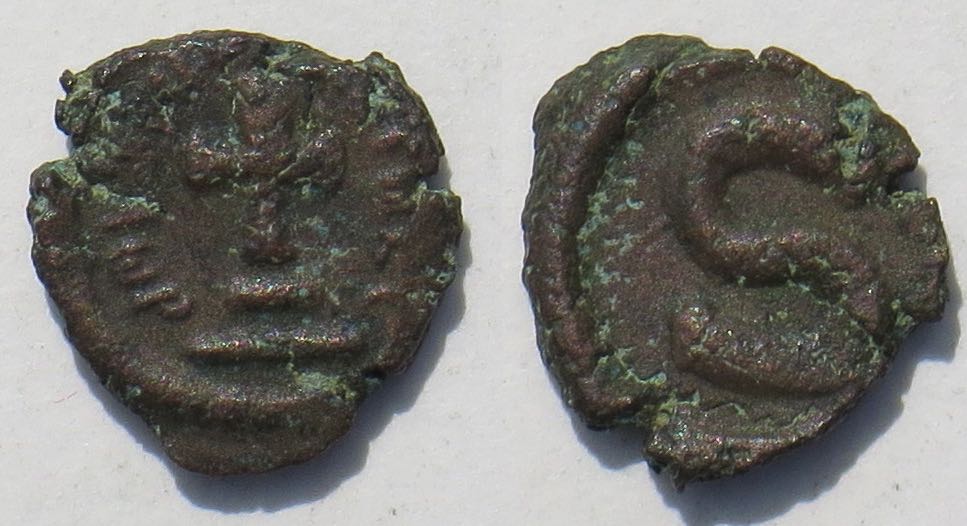 Heraclius, 610-641
Heraclius, 610-641
13 mm. 1.76 grams.
Cross and legend/large S for 6.
Sear 862. No mintmark. Alexandria.
Thessalonica issued several unusual denominations including 2, 3, 4, 8, and 16 nummi. Here is a 3-nummus piece.
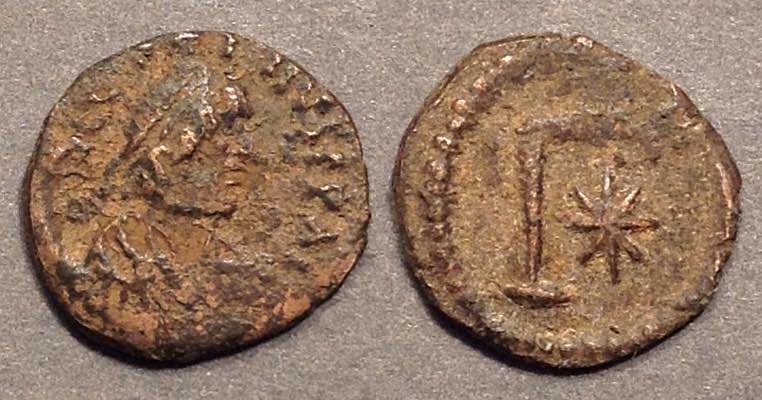 Justin I, 518-527
Justin I, 518-527
12-11 mm. 0.77 grams.
Gamma (3) and star
Sear 81. No mintmark. Thessalonica.
Carthage issued a 2-nummus piece. It is small.
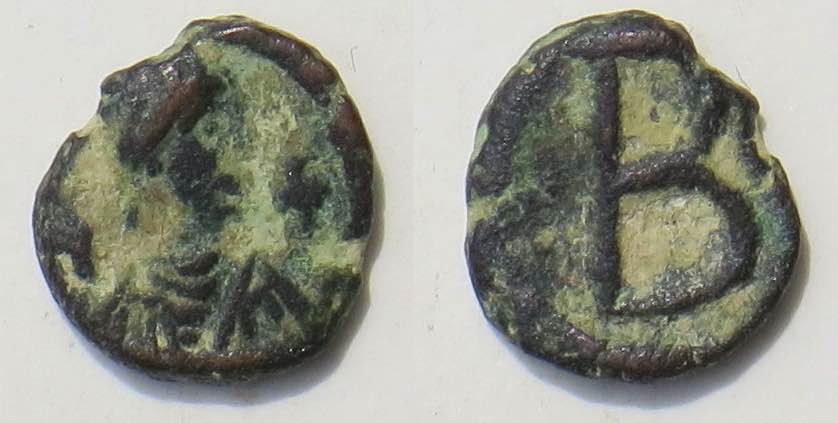 Justinian, 527-565.
Justinian, 527-565.
12-10 mm.
B for 2-nummi.
Too small to have a useful obverse legend.
Sear 277 from Carthage.
Rare.
Cherson. Cherson is a city in Crimea, a peninsula into the north of the Black Sea. It was a remote outpost in a region that provided wheat to Constantinople. Its coinage was usually much different than elsewhere. At about the time of Maurice (582-602) it changed the numeral on the follis from M for 40 to H for 8, reckoning in units of 5. (8x5 = 40.) (The first example is repeated from page 1.)
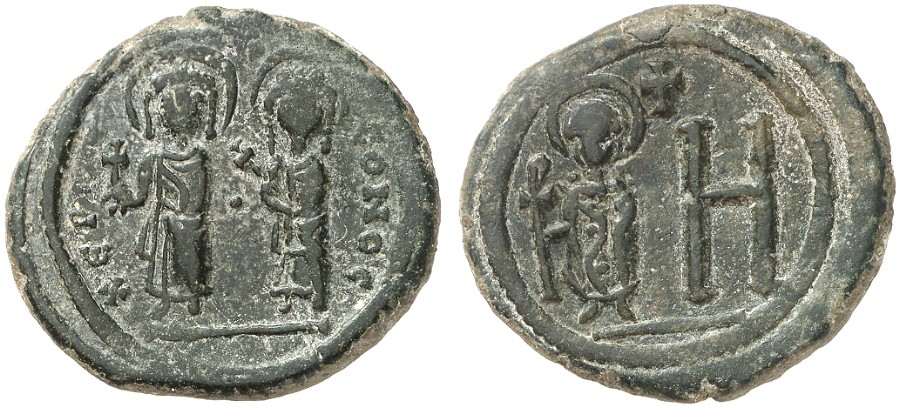 An anonymous follis of Cherson, with legend
An anonymous follis of Cherson, with legend
XEP - CONOC ("of Cherson")
33 mm. 14.69 grams. Follis.
Two standing figures
One standing figure and a large H (= 8) to the right.
All coins from Cherson used to be rare in the west, but are more common now that Ukraine and Russia have opened up. This type used to be attributed to Maurice because there is a nearly-identical type with his name, but many dealers have adopted the attribution of Anokhin, a Russian scholar who attributed this type to Justin II (565-578). I have read Anokin's arguments (in translation) and find them far from convincing. I prefer to retain its attribution to the time of Maurice.
A a half-follis is 20 nummi, so, reckoning in pentanummi, it is 4 pentanummi (4x5 = 20). The half-follis is labeled with "4", that is, with "Δ".
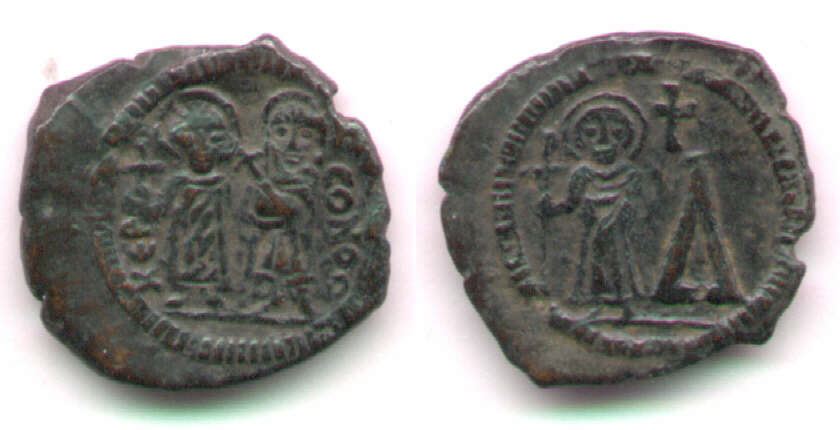
An anonymous half-follis of Cherson, with legend
XEP - CONOC ("of Cherson")
24 mm. 7.01 grams.
The identities of the three figures are uncertain.
Sear 610, attributed there to Maurice (582-602). I agree with Sear, but not everyone does and some give it to Justin II.
Rare.
For much more on the mint of Cherson, including small cast coins unlike any other Byzantine coins, see my page.
Less-Useful Greek Letters. The remaining Greek letters appear occasionally, but you need not learn them as a beginner. Here they are anyway.
H eta, our E (not our H)
Θ theta, our TH
Ξ Xi, our X
Π pi, our P
P rho, our R [tricky!]
Σ sigma, our S, sometimes "lunate", that is, shaped like our "C": C
Y upsilon
Φ phi
Ψ psi, our PS
Ω omega, our O
There is a page "Byzantine-coin legends. How to read Byzantine coins" with more about the numbers, letters, and words found on Byzantine coins.
More examples. From Justinian through the mid-seventh century most Byzantine coins you will see have an M, a date (in Roman numerals), and an officina number (in Greek). See if you can decipher these examples.
 Justinian, 527-565
Justinian, 527-565
Follis. 32 mm. 16.89 grams.
The obverse legend begins at 8:00 with DN IVSTIN ...
ANNO = year
X
X
IGI [the "G" is a 6]
I
for 29. Officina Γ (= 3).
Mint of Constantinople. Sear 163.
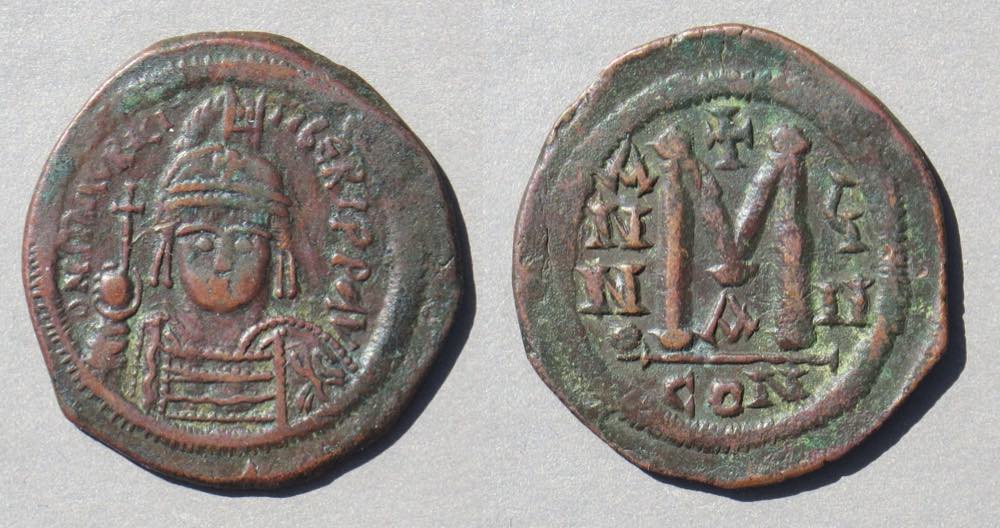
Maurice, 582-602
(The obverse legend begins DN MAVR ...)
34-32 mm. 13.30 grams.
DN MAVRICI TIbЄRI PP AV
His name was Maurice Tiberius but we call him Maurice to minimize confusion with Tiberius II who also had "Tiberius" in his name: Tiberius Constantine. "TIB" could be on either of their coins, which are often in poor condition with the obverse legend very hard to read.
Large M, cross above, A [the Greek numeral "1"] below
ANNO GII. Year 8.
Sear 494

Justinian, 527-565.
40-nummum. Year 19 (This time the U = V is not bent over to make a 6--it is a 5)
at KYZ = Cyzicus.
Large. 35 mm. 19.33 grams.
Sear 207. Struck 545/6.
After the mid-seventh century the "M" of the follis denomination is retained until the ninth century, but the date is no longer used.
Leo V, and Constantine, 813-820.
Facing bust of Leo (on the left) and Constantine
23 mm. 5.62 grams. A follis, smaller than 6th-century folles.
LEOҺ S COҺST [The middle S denotes "and"]
The "M" still means it is a follis, but the other letters are "immobilized" and have become fixed and meaningless, although they remind us of the "ANNO, date, officina" formula from earlier centuries. In this century, in contrast to the many varieties of 6th century folles, this emperor has only three distinct copper types.
Sear 1630.
Then the M for 40 disappears entirely.

Theophilus, 829-842
28-27 mm (above) and 23-22 mm below).
For hundreds of years the follis was the only low-denomination coin.
However, Theophilus issued a half-follis with exactly the same design as his follis.
+ΘЄO/FILЄAVG/OVSTSV/ҺICAS
Theophilus Augustus May You Conquer
Sear 1667 (above) and Sear 1668 (below).
Note for collectors: Sizes can be difficult to tell from internet pictures. Be careful when you buy coins to determine the size of the coin. This is especially important with Greek silver coins because Greek cities often used the same design on all their denominations from the large to the tiny. A seller might use a very large photo of a tiny coin.
These two images are to scale. The second coin, with the same design, is much smaller than that first. It may be a "half-follis".
Flans and Quality Control. After about 640 the empire was in very difficult straits. The coins show the strain. There is almost no quality control. Some flans were simply quarters of larger earlier coins.
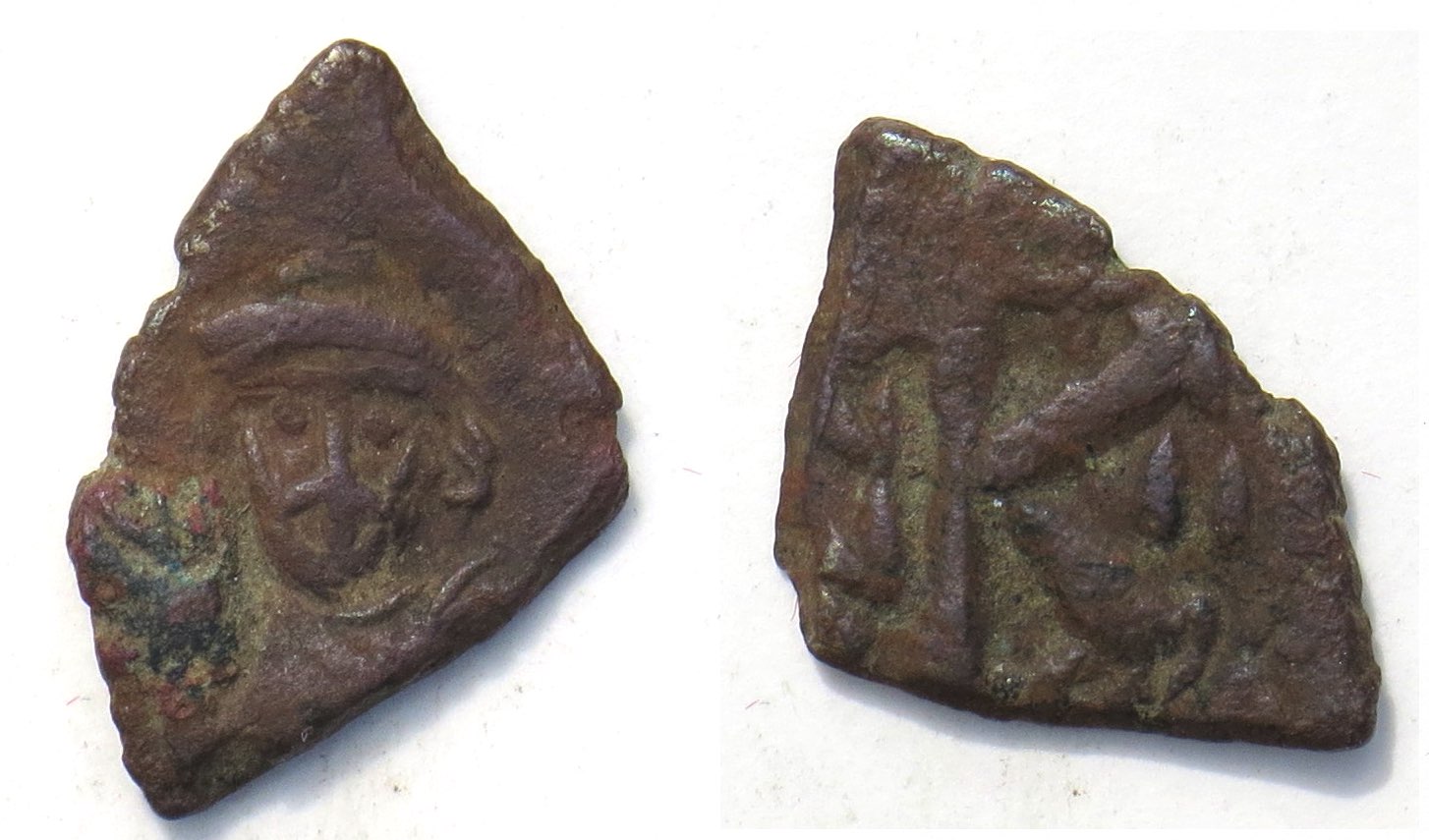
Justinian II. He had two distinct reigns, 685-695 and 705-711.
(The story of his downfall and dramatic return to the throne is remarkable.)
This flan is one quarter of a large earlier flan.
24 mm maximum, 16 mm minimum. 3.23 grams.
K (20-nummum)
Remains of "ANNO" and "II", but it is not clear that dates were being properly recorded on coins. It is not certain this is really from Justinian II's year 2.
Sear 1262, first reign.
(Almost none of the copper coins of Justinian II are anywhere near nice by standards other than comparison with the rest of his own wretched coins.)
Comment. On Roman coins the obverse legends were almost always well-engraved, reasonably well-struck, and can be read well-enough to identify the emperor on even low-quality coins. This is not the case for Byzantine copper. Often legends are poorly engraved or poorly struck and hard to read.
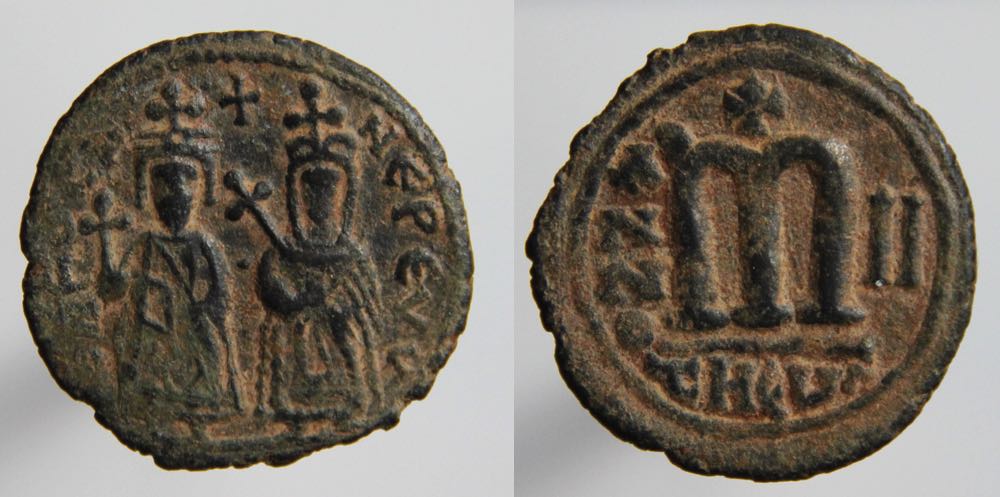 26 mm. 7.25 grams
26 mm. 7.25 grams
This is a beautiful example, far above average, but of which emperor? On the right side the ending of the obverse legend is clear: NЄPЄVV (although blundered), but the name should be on the left side which is unfortuntely weakly struck.
Two standing figures facing are commonly on coins of Justin II and Sophia, but not exactly like this.
Comparison with examples in reference works identifies this as a coin of Phocas. The legend is something like ON FOCA NЄPЄVV (and should end AVG).
Sear 671. At Antioch renamed as Theopolis.
Note for Collectors. This coin is desirable for its size, centering, surfaces, lack of wear, and clarity of design, even though it is not fully struck up. If you decide to collect Byzantine coins, you will get used to this.
Some rare early mints and denominations have been omitted above and are discussed on page 2A.
The next page, page 3, illustrates Byzantine copper coins by emperor from 491-c.1118.
Page 4 is "Late Byzantine AE, 1059-1204 (Constantine X to the fall of Constantinople to the crusaders)."
Page 5 is "Byzantine Coins, 1204-1453."
To learn more you can surf the web or get a book on Byzantine coins. I offer some recommendations here.
This was page 2. Return to page 1 and its Table of Contents.
 Justin II and Sophia, 565-578
Justin II and Sophia, 565-578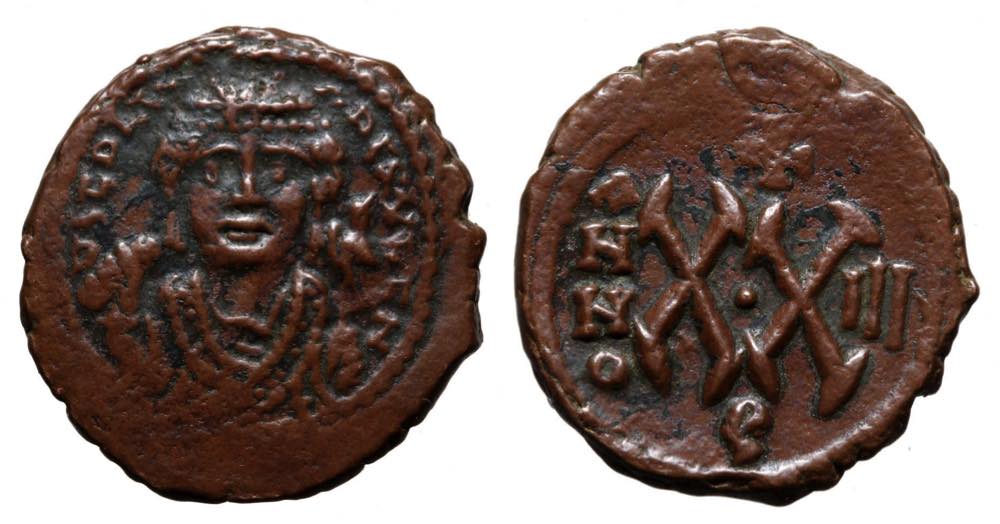
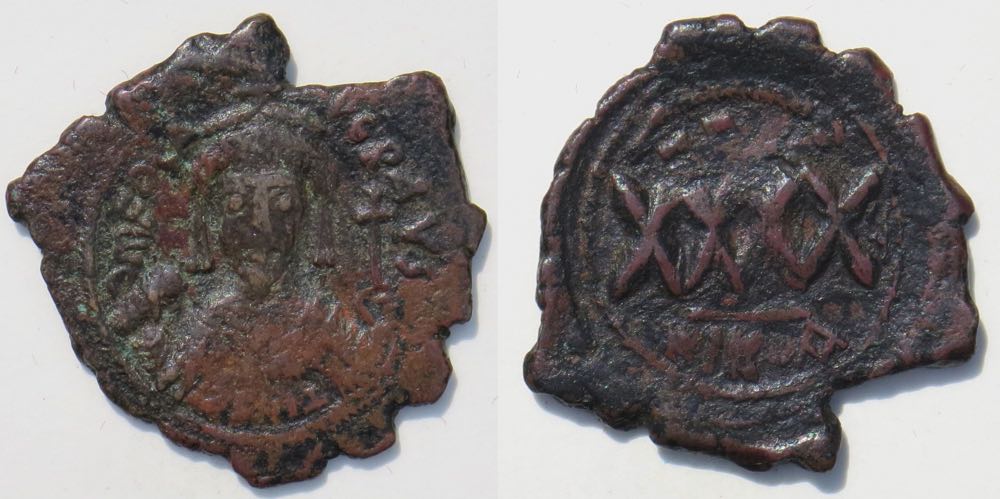
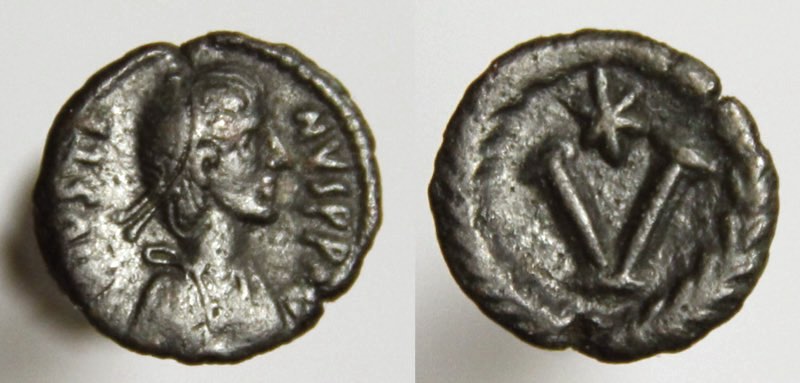

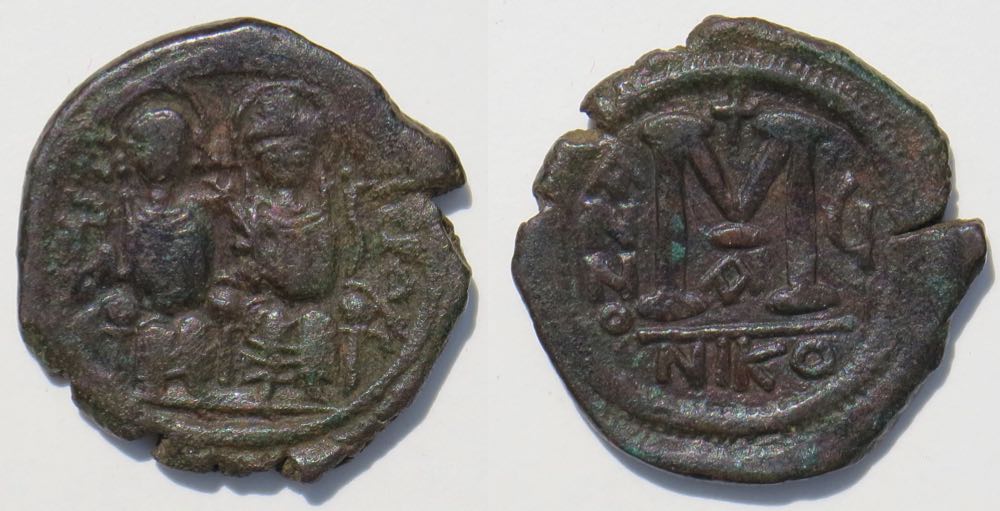
 There is a second "A" in the next image.
There is a second "A" in the next image.
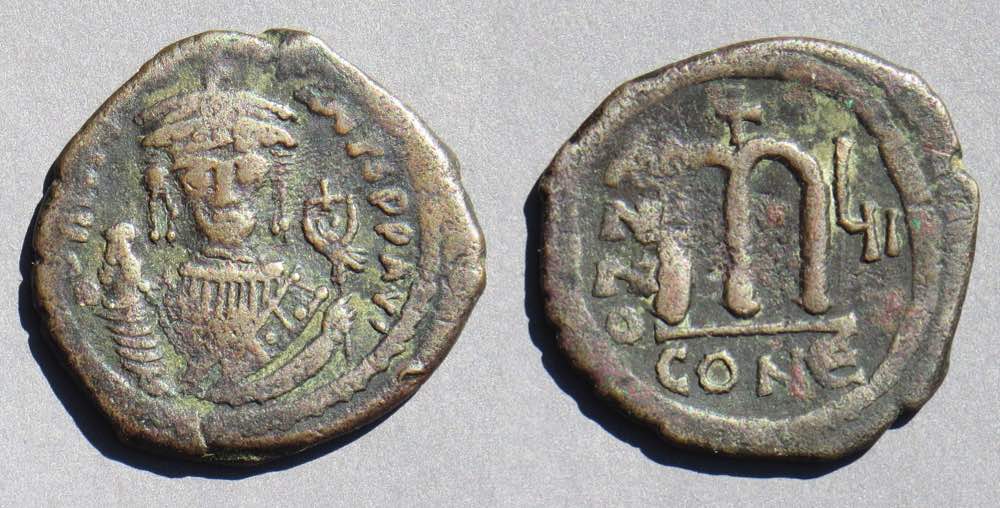
 Officina Γ (= 3) below the middle of the M
Officina Γ (= 3) below the middle of the M
 Justinian, 527-565.
Justinian, 527-565. Justinian, 527-565.
Justinian, 527-565. Justinian (527-565)
Justinian (527-565)

 Justinian, 527-564
Justinian, 527-564
 Heraclius, 610-641
Heraclius, 610-641 Justin I, 518-527
Justin I, 518-527 Justinian, 527-565.
Justinian, 527-565. An anonymous follis of Cherson, with legend
An anonymous follis of Cherson, with legend
 Justinian, 527-565
Justinian, 527-565

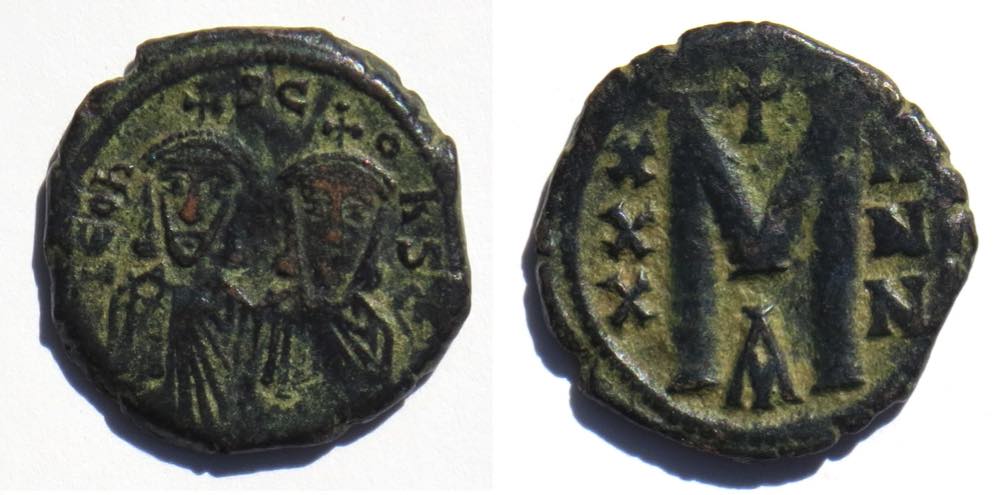


 26 mm. 7.25 grams
26 mm. 7.25 grams